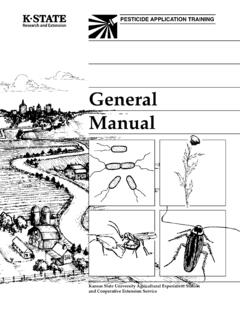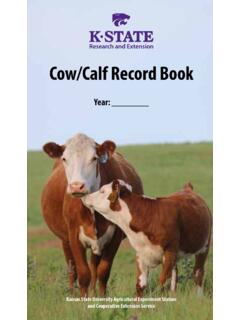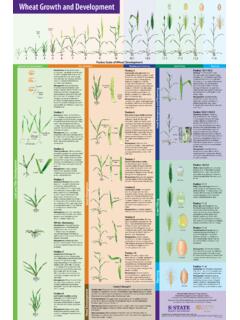Transcription of K A N S A S GARDEN GUIDE - Kansas State University
1 Kansas . GARDEN . GUIDE . Kansas State University Agricultural Experiment Station and Cooperative Extension Service Kansas . GARDEN . GUIDE . Charles W. Marr Horticulturist, Vegetable Crops Ted Carey Horticulturist, Vegetable Crops Raymond Cloyd Entomologist Megan Kennelly Plant Pathologist 1. 2. Contents 5 Introduction 21 Seeding and Planting 21 When To Plant 6 Planning a GARDEN 21 Preparing the Seedbed 6 Soil 22 Seeds 6 Selecting What to Grow 22 Producing Transplants 6 Optimizing GARDEN Space 23 Transplanting 7 Make a Sketch 7 Obtaining Seeds and Plants 24 As the GARDEN Grows 8 Tools and Supplies 24 Thinning 24 Weeding and Cultivating 9 Composting 24 Pruning 9 Chemistry of Compost 24 Staking and Tying 9 Getting Started 10 Making the Compost Pile 25 Watering the GARDEN 11 Quick Composting 25 Watering Efficiently 11 Grass Clippings 25 Principles of Plant Water Use 11 Using Compost 27 Suggestions for Applying Water 12 Cautions in Using Compost
2 27 Methods of Applying Water 29 Mulching 13 Soil Improvement 29 Ten Ways to Improve GARDEN Water Use 13 Adding Organic Matter 13 Getting a Soil Test 30 Fall Gardens 14 Taking a Soil Sample 30 What To Plant 14 Controlling Soil pH 31 When To Plant 14 Fertilizing the GARDEN 31 Fertilizing and Soil Preparation 14 Fertilizer Types 31 Establishing Vegetables in summer Heat 16 Calculating the Amount of Fertilizer 31 Watering Needed 32 Frosts and Freezes 19 Getting the Most From Your Fertilizer 19 Some Useful Measures 20 Applying Fertilizers 3. 33 Insect and Disease 54 Cauliflower 55 Chinese Cabbage Control 55 Cucumber 33 Checklist of Good Gardening Practices 56 Eggplant 35 alternatives in Pest Control 57 Endive/Escarole 36 Integrated Pest Management 57 Kale 36 Pesticides 57 Kohlrabi 37 Alternative Pesticides and Control 57 Lettuce and Other Leafy Greens Methods for Specific Crops 58 Muskmelons 59 Mustard 40 Container Gardening 59 Okra 40 Soil Mixes 60 Onions and Onion Relatives 40 Containers 60 Parsley 41 Fertilizer 61 Parsnip 41 Watering 61 Peas 41 Culture and Care 61 Peppers 42 What to Grow 62 Potatoes 63 Pumpkin 43 Season Extension 64 Radishes 43 Crop and Cultivar Selection 64 Rhubarb 43
3 Maximize Yield 65 Salsify 44 GARDEN Site Selection 65 Spinach 44 Raised Beds 66 Squash 45 Mulches 67 Sweet Corn 45 Other Forms of Protection 67 Sweet Potato 46 Low Tunnels 68 Tomatoes 47 High Tunnels 69 Turnip and Rutabaga 48 Provide Shade 69 Watermelon 49 Harvesting and Storing 71 Herbs 49 Storage Conditions 71 Location 49 Select the Best 71 Care 49 Check Storage Areas Regularly 71 Getting Started 49 Storing Vegetables 72 Harvesting 50 Recommended Vegetable Storage 72 Drying Conditions 72 Storage 72 Herbs in Containers 51 Vegetable Crops 73 Annual Herbs 74 Perennial Herbs 51 Asparagus 52 Beans 52 Beet/Swiss Chard 75 Vegetable Crop 53 Broccoli Information 53 Brussels Sprouts 54 Cabbage 76 Vegetable GARDEN 54 Carrot Calendar 4.
4 Introduction Vegetables are an important part of our diet, and millions of Americans are home gardeners. In Kansas , home gardeners produce $15 $20 million worth of vegetables every year. A well-planned and properly tended GARDEN Gardening is an excellent 4-H or youth proj- can provide food for a family throughout the ect. It can provide a source of income as well as year. Most home gardeners agree that home an outlet for energy. grown produce has the ultimate in vegetable The GARDEN is also an excellent laboratory flavor. Surplus vegetables can be frozen, for experimenting with plants. Everyone can canned, or stored, making the home GARDEN learn from simple experiments in the world of enjoyable year-round.
5 These vegetables not plant science. only provide food budget savings but also Successful gardens are the result of careful make a valuable contribution to nutrition. planning, watchful care, and good manage- The food from a vegetable GARDEN is only ment. With a few simple tools, a little land, one of the many benefits of home gardening. and a desire to nurture plant growth, anyone The relaxation and enjoyment derived from can become a home gardener. This GARDEN gardening is well known to all home GARDEN - GUIDE will assist in achieving a successful ers. A GARDEN allows even the youngest family home GARDEN . member to help in gathering food. 5. Planning a GARDEN Planning a GARDEN Locate the GARDEN in an area that will not interfere with the home landscape.
6 A sunny, level area away from large trees is preferable because tree roots compete for soil nutrients and water. A source of water should be accessible for periods when irrigation is necessary. In many Kansas locations, protection from experiment with unfamiliar vegetables, but wind is desirable. Take advantage of fences, plan to be able to use most of the vegetables small shrubs, or buildings that provide a you produce. windbreak. Most home gardeners have too much pro- duce maturing at the same time. This is desir- Soil able if you plan to can or freeze the vegetables. Vegetables grow best in well-drained, fertile For table use, it is best to stagger plantings.
7 Soil. Sandy loam soils are ideal for vegetables. Plant a few radishes every 4 5 days instead of Most home gardens, however, do not have this all at once. This will provide a steady supply of soil composition. Compost or manure spread radishes of ideal maturity over a longer time. over the GARDEN and worked in with a GARDEN Also stagger plantings of lettuce, beans, sweet tiller will improve not only fertility but also corn, and peas. soil tilth. Adding organic material such as manure or compost is an important practice in Optimizing GARDEN Space successful gardening. Use the Vegetable GARDEN Calendar in the back of this book to plan your GARDEN space. Selecting What to Grow Spinach, lettuce, radishes, peas, and green A wide variety of vegetables can be grown onions can be harvested early in the season.
8 In Kansas . Space available and individual The same space is then available for late- preferences play an important part in deciding season crops of beans, eggplant, tomatoes, or what to grow. Beans, beets, summer squash, potatoes. Plant lettuce, radishes, or spinach peppers, tomatoes, lettuce, onions, radishes, between potatoes, cabbage, or other cole crops. and turnips are well adapted for growth when Before the potatoes or cole crops get very large, space is limited. the other vegetables will have been harvested. Sweet corn, vine squash, cucumbers, Select a place along one side of the GARDEN pumpkins, and melons require more space for crops such as rhubarb, asparagus, straw- for growth and should be considered only if berries, or bush fruits.
9 These perennials will adequate space is available. Don't be afraid to continue to grow next year without replanting. 6. Planning a GARDEN If planted in the GARDEN , they will be in the Ask your local K- State Research and way during tilling operations. Extension agent for the publication, Recommended Vegetable Varieties for Kansas , Make a Sketch L41, or order from Production Services by Draw a scale model of your GARDEN space sending an e-mail to and plan the GARDEN using the above informa- Use varieties that have performed well for tion. Allow everyone involved to participate you or other gardeners. by suggesting their favorite vegetables. Make If you plan a special use for a particular notes on the plan and save it as a reference for vegetable, such as freezing, exhibiting, or next year's GARDEN .
10 You can also use this plan canning, check with your local agent or when ordering seeds and plants. study seed catalog recommendations. Check with your local seed store or GARDEN center for advice on what to plant. Obtaining Seeds and Plants If you do not have a seed starting structure, In choosing varieties for the home GARDEN , you may want to buy vegetable transplants for consider factors such as disease resistance, crops that require transplanting to the GARDEN . yield, maturity date, size, shape, color, and These can be obtained from local greenhouses flavor. Seed companies and State agricultural or seed and GARDEN centers. Again, make sure research stations are constantly developing the varieties are what you want to produce.





